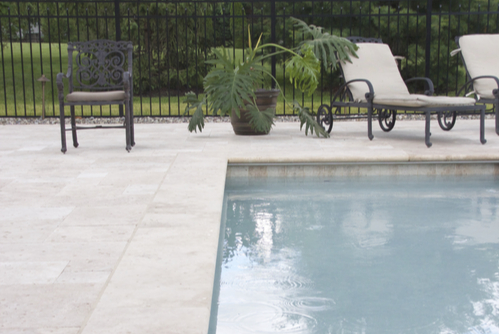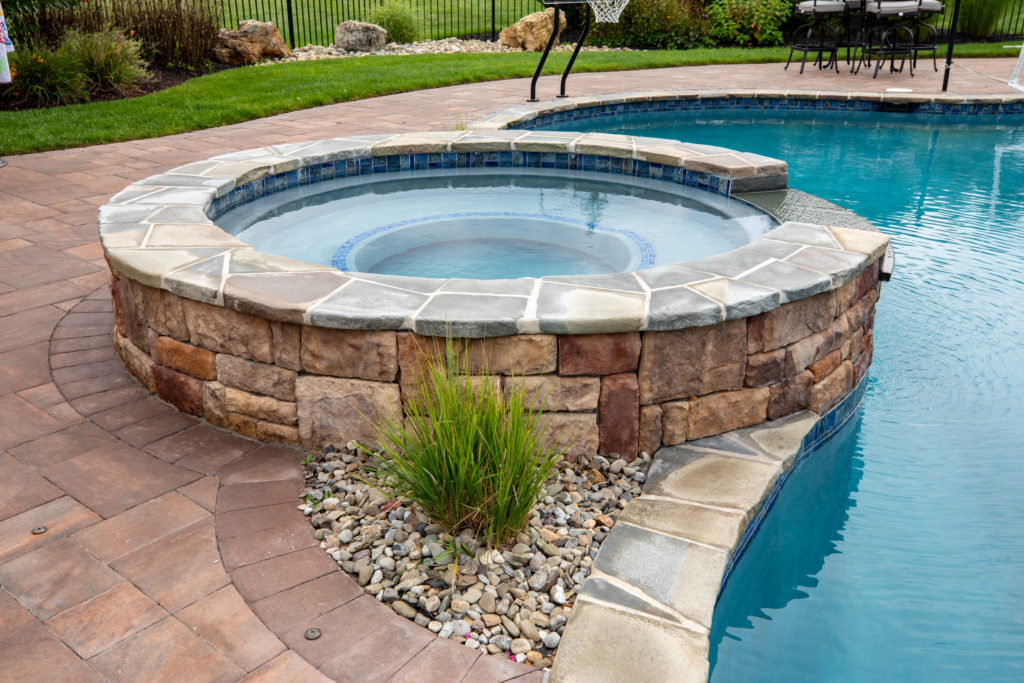Pool Building May Incorporate More Decisions Than You Think
Choosing to build an in-ground pool is just the first decision of many.
Next come the details; Which type of building material do you want to use? What kind of pool coping do you want? Which added features do you want your pool to have?
Pool coping is not something most homeowners think about initially, but it is an important part of every in-ground pool.
When an in-ground pool is built, the upper surface of the pool wall will likely have exposed steel (also known as the bond beam). Pool coping covers the bond beam surrounding your pool, capping off the pool walls.
Pool Coping Benefits
Pool coping provides many ergonomic and aesthetic benefits, including:
-
- Directs splashout away from pool and into deck drain
- Keeps debris, such as grass, leaves, and dirt, out of the pool
- Prevents water from entering the area behind the pool shell, which can subsequently cause damage
- Provides an attractive yet accessible cover to mechanical pool components
- Reduces the risk of slipping, thereby allowing swimmers to safely enter and exit the pool
Pool Coping Decision Factors
So how do you decide on which pool coping to use? There are some key decision factors to keep in mind when making your choice:
-
- Durability
How long is the material going to last? Is it able to withstand chlorine water and/or salt water? Will it hold up to the weather extremes in your area?
- Durability
-
- Safety
Is the material sturdy? Slip resistant? Heat resistant?
- Safety
-
- Affordability
Is the material within my budget? How much does maintenance cost?
- Affordability
-
- Style
Does the material mesh with your backyard’s overall aesthetic? Can it provide the look and design you’re looking for?
- Style
Another factor to consider (depending on which type of pool coping style and material you use) is whether you would like mortar joints, which are the spaces between the stone, brick, and or concrete. The motor joints can be designed to be different colors, but a drawback to choosing a unique color is its ability to be replicated in the future should it need replacing.
Pool Coping Style
The style of pool coping is a matter of personal preference. There are four popular pool coping styling options:
-
-

Bullnose and tumbled boulder pool coping by Darlington Designs Bullnose
A rounded edge finish, typically paired with classic and traditional designs
-
-
- Square Edge
As the name suggests, this style has square edges, and is typically paired with modern and contemporary designs
- Square Edge
-
- Drop-down
A hidden edge or rim that gives a seamless appearance
- Drop-down
-
- Tumbled
A slightly uneven edge profile that gives a more natural, rustic appearance
- Tumbled
Pool Coping Material Options
There are various pool coping materials options homeowners can choose from, but these are the three most popular:
Natural Stone
For those looking to incorporate a natural feel to their pool, natural stone is the best option. There are many different natural stone materials to choose from, such as:
-
-

Travertine pool coping by Darlington Designs Travertine
One of the most popular natural stone materials, travertine is known for its ability to be virtually slip-resistant and remain cool to the touch. This durable material usually comes in ivory, brown, and gold tones, and typically comes in one of three finishes: polished (shiny and smooth), honed (matte and smooth), and tumbled (porous and textured).
-
-
- Flagstone
This is a common term for flat slab natural paving. It is a durable class of natural stone that is known to be slip, heat, and moisture-resistant. It is easily installed and is the best choice for unique, one-of-a-kind creations.
- Flagstone
-
- Sandstone
This is a hard-wearing, even-toned stone that is comprised of quartz grains. It typically comes in light brown or red, and is preferable for monochrome designs.
- Sandstone
-
- Limestone
This well-rounded, highly durable material is not only used for pool coping, but to build decks as well. It comes in a variety of colors and can be cut into many different shapes and sizes, making it a great choice for those looking to build a unique style. -

Patterned bluestone pool coping by Darlington Designs Bluestone
Bluestone is a type of flagstone, but specifically mined in NY or PA. Usually coming in a blue/gray color tone, it is typically finished in one of three ways: thermal (uniformed texture), natural cleft (non-uniformed texture), and honed (smoothed texture). Darlington Designs uses the highest quality Pennsylvania Bluestone for their natural stone pool coping projects.
- Limestone
-
- Slate
A type of flagstone that is heavy and durable, it is easy to install and can be cut into different shapes, sizes, and lengths. It also comes in a variety of colors (ranging from blacks and browns to greens and purples).
- Slate
-
- Granite
Made primarily of quartz, this hard natural stone is best at holding shine, repelling water, and withstanding adverse conditions.
- Granite
Brick/Concrete Pavers

Brick is a durable and stylish material that is a popular choice amongst homeowners, especially if your backyard already has pre-existing brick. It is not as expensive as natural stone, but just as versatile in terms of style and colors.
Concrete pavers are another pool coping option that allows you to flex your design and styling muscles without the cost of natural stone. In fact, some designers are even able to mimic the look of natural stone, such as the Devonstone Saw Cut by EP Henry, with whom Darlington Designs partners with when installing this type of pool coping.
Precast Concrete
This option is the least expensive of the three mentioned above, but it is the most susceptible to cracking in extreme weather. It is available in a wide range of patterns and textures, and is very easy to install. This is because it is manufactured using a template of your pool or spa, so little to zero cutting is needed during the installation process.
Pool Coping Alternatives
Pool coping is generally considered a necessary component of in-ground pools, because it protects the mechanics of the pool, and alleviates some major safety issues that swimmers can experience. However, if you don’t want pool coping, there is an alternative option available to some homeowners. If you are currently building a deck, or you have a pre-existing wood or concrete deck, you can enlarge it to extend slightly around the perimeter of the pool. If this is not applicable to you, you will most likely need to purchase traditional pool coping.
A Superior Pool Coping Experience with Darlington Designs
We have more than 15 years of experience in custom pool and spa building, as well as outdoor living spaces and construction. Our knowledgeable team operates as a “one-stop shop” for our clients, taking ownership of the entire project from the initial design to the final build. We work closely with our clients throughout the entire process, ensuring they are fully informed and happy every step of the way.
To better prepare for your pool-building experience, download Darlington Designs’ informative guide, 38 Questions To Ask Your Home Pool Contractor.
At Darlington Designs, we’re committed to executing your pool visions. Contact us today at info@darlington-designs.com or call us at 856-442-0440. We proudly serve local neighborhoods in southern New Jersey and the greater Philadelphia region.
Also, feel free to contact us via our project form on our site. The project form can be found at the bottom of our Pools & Spas page.


